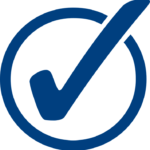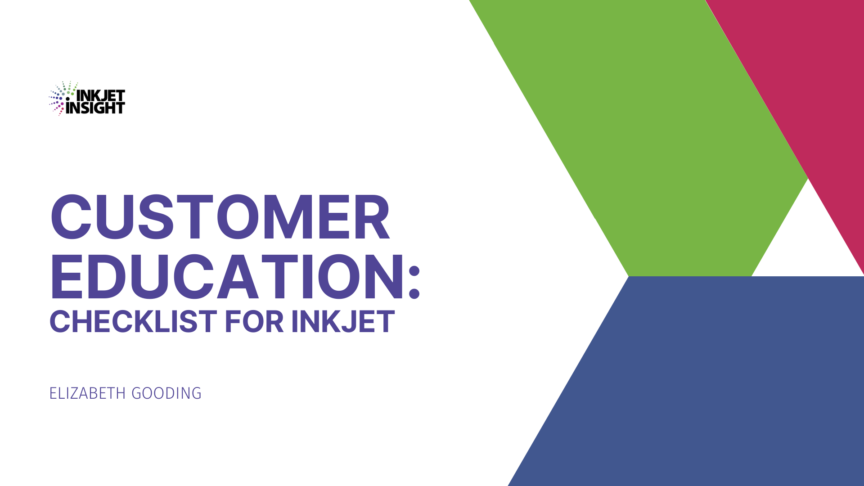Educating customers on the potential for inkjet in their business, as well as the processes needed to get the best quality, is important to gaining momentum with inkjet. We’ve provided a customer education checklist because we want you to make creating an inkjet customer education plan a priority for the coming year. Creating a solid customer education plan has many potential benefits for your company:
- It may be the best marketing you ever do
- It solves operational problems before they happen
- It builds your brand reputation through better customer experience
Often, the process of documenting standards and creating guidelines for customers also uncovers opportunities for improvement and makes your sales team more productive.
Who needs education?
There are multiple audiences who need to learn about your inkjet capabilities, each with different needs:
- Marketing and operations executives – your education should build awareness of the opportunities and benefits that inkjet can bring to them as customers.
- Sourcing and procurement professionals – help them steer their RFPs and RFIs towards production outcomes rather than production platforms. Open their eyes to the potential to save money through improved efficiency and effectiveness rather than strict cost per image.
- Designers and Creative Directors – this is the most extensive area for education. Creatives must consider production much sooner in the design process than they have in the past. You must supply them with the tools and education to make good design choices that will run as expected in your environment.
For all of these audiences, you have a vested interest in getting them educated, but you also have to convince them that it’s worth their time to care. You need to consider what you can do to engage everyone from the buyer to the person who creates the PDFs or other print-ready files that ultimately end up on your shop floor. They need to understand what they can do with your specific implementation of inkjet and finishing so that they will be excited about the opportunities that this opens up to do some things that they couldn’t do before – or do them faster, or in shorter run lengths or both.
When to start planning
You should start planning your education in parallel with inkjet purchase so that you can use your testing time with OEMs most effectively. Make sure that the inkjet materials you prepare for evaluating and installing the equipment can also be used to support sales and marketing – this should include application samples, tint books and fingerprint files. All of these should be designed using the documented color space and file settings that you will then communicated to your customers and printed on your inkjet device using papers that have been linearized, profiled and approved for production.
Starting in parallel with the purchase makes the most of your testing time and resources and gives your sales people time to ramp up and start selling so that you can achieve break-even volumes as quickly as possible.
If you already have inkjet – it’s not too late to start. I’ve worked with clients who had very low volumes on their inkjet devices in the first 6 months after purchase. Once they started with customer education (often in concert with some market positioning strategy and sales training) their success ticked up quickly. Keep moving through your customer education checklist and add materials as quickly as you can, and remember to check back for more resources here on Inkjet Insight.
 Customer Education Checklist and Starter Resources from Inkjet Insight
Customer Education Checklist and Starter Resources from Inkjet Insight
Here are some of the critical areas that you need to include in your inkjet education plan. We will continue to drill down on each area of the customer education checklist in future posts. Several already include links to resources you can use – note that they are mix of free posts, tools that require free registration to dowload and a few that are only available with a premium membership.
Content: blog posts, web-downloads, PDFs to attach to email and/or inkjet-printed hard copy
- Articles on the benefits of your inkjet implementation
- Case studies on your customers using inkjet (if and when available)
- Basics articles on variable printing for customers new to personalization and versioning
Content to add to your website
You may want to require customers to log in to reach certain aspects of this information (like we do!)
- General information on proper packaging of design files (see file packaging post here)
- Guidelines and recommendations for monitor calibration (see example from Adobe on education)
- Documented file preparation standards specific to your company
- Instructions for using a tint book for color matching (see free with registration tint book and premium-only tint book)
- Instructions for using a fingerprint file to assess design considerations (see more on fingerprint and premium-only download fingerprint)
- Available list of standard/approved papers
- Profiles for linearized and approved papers
- Guidelines for requesting non-standard papers and discussion of cost and timeline
- Design tips for addressing challenges with images, vignettes and out-of-gamut colors
Information available in hard-copy (printed on inkjet)
- Print samples that demonstrate the benefits of inkjet
- Print samples that compare and contrast to other devices in your portfolio if applicable
- Tint books printed on approved stock (see free with registration tint book and premium-only tint book)
- Fingerprint files printed on approved stock (see premium-only downloadable fingerprint file)
Extra Credit: Presentations and course material
- Consider providing general design education through webinars or live classes. You can also share links to recorded educational webinars from Inkjet Insight and other sources if you don’t have your own platform.
- Many corporate designers, particularly those at smaller companies may not have much formal design education.
- Limited knowledge limits their opportunities to get the most out of inkjet and increases your likelihood of ending up with sloppy files or designs that slow production.
Did you find this checklist useful? Have ideas for other customer education tools? Please let us know.

